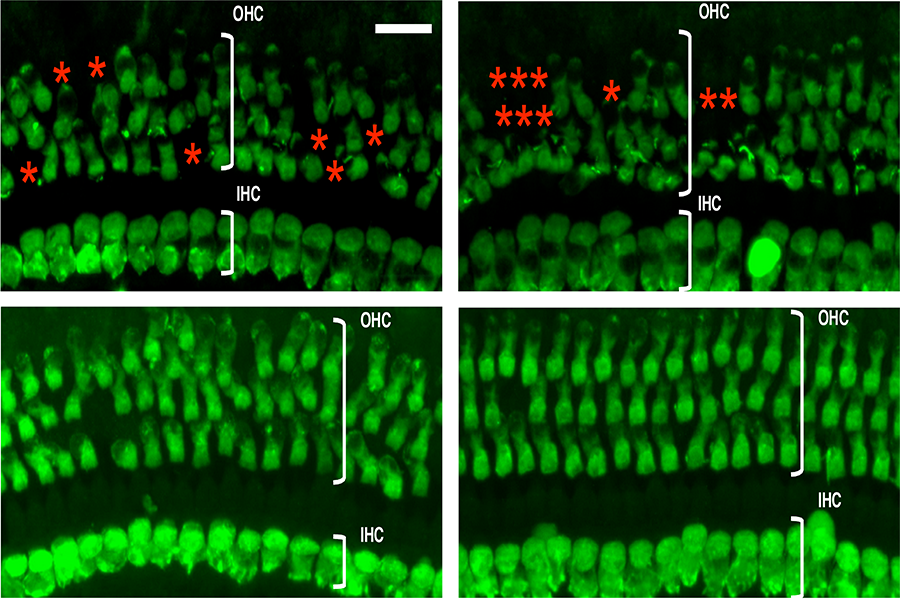With Gene Editing, Mice with a Form of Inherited Deafness Can Hear Again
July 16, 2024
Approach restores hearing in adult mice, opening new possibilities to treating genetic conditions in people
Researchers have used gene editing to restore hearing in adult mice with a type of inherited hearing loss. They showed that shutting down a damaged copy of a gene called a microRNA (miRNA) enabled the animals to regain hearing. The approach by a research team supported by the National Institutes of Health (NIH), reported in Science Translational Medicine, may eventually lead to potential treatments for inherited hearing loss in people.
Zheng-Yi Chen, DPhil., and his colleagues at Mass Eye and Ear in Boston and other institutions studied a rare form of genetic deafness called autosomal dominant deafness-50 (DFNA50). DFNA50 is caused by mutations in the microRNA-96 (MIR96) gene. MiRNAs are pieces of genetic material that help control gene activity, acting like a master switch. Mutations in miRNAs have been linked to several types of inherited hearing loss. In people with DFNA50, progressive hearing loss develops in the teenage years.
According to Chen, researchers had proved it was possible to use gene therapy (replacing a gene) and gene editing (modifying a gene) to treat genetic deafness in newborn mice, but no one had shown that gene editing was possible in the adult animal inner ear. The human inner ear is fully developed in newborns. In contrast, the newborn mouse inner ear is still developing and changing in structure and function.
“We thought that if we could show we could treat deafness in a fully mature mouse model, we might increase the likelihood it would work in humans,” Chen said.
The scientists focused on a specific mutation in the MIR96 gene. The mutation controls genes important in the development and functioning of hair cells in the ear. Hair cells act as sensors to detect sound and motion and are crucial for hearing.
Chen and his team turned to a CRISPR/Cas9 gene editing approach. Using a type of virus called AAV, or adeno-associated virus, the scientists delivered the gene editing machinery to the inner ear hair cells of mice with the MIR96 mutation and the genetic form of deafness. They tested the treatment on newborn mice before the onset of hearing loss and in adult mice with hearing loss. Treatments at both time points worked, and earlier intervention proved more beneficial.
“Gene editing is useful for this type of genetic deafness because only one gene copy mutation is needed to prevent the entire gene from working properly and causing disease,” Chen explained. “Using gene editing techniques, we prevented the mutation’s effects, essentially eliminating the bad gene copy. The normal gene copy continues to work, and this restores function to the gene.”
Chen said that creating a mouse model that mimicked the genetic mutation and the progressive hearing loss in people with DFNA50 was key.
“We reversed the animals’ hearing loss, and this was sustained for at least nine months,” Chen said. “We think the result should be applicable in people.”
The researchers also showed evidence that the intervention was safe. The delivery virus didn’t integrate into the genome of the cells it infected, which can be concerning for possible side effects.
Chen termed the study a “proof-of-concept” to show this type of gene editing was possible in the adult mouse. To bring this work to the clinic, researchers will need additional preclinical tests in different animal models to make sure the treatment is safe and going to the right cells.
A similar approach can be used for other types of genetic deafness with these kinds of mutations. The scientists developed a method to target more than one MIR96 mutation, making it a promising way to treat multiple forms of hearing loss caused by different mutations in the same gene.
Chen and his collaborators have also reported encouraging results this year from clinical trials looking at a gene therapy approach for another form of deafness, DFNB9.
“There’s been so much progress in understanding and treating genetic hearing loss, and especially the recent success in gene therapy,” said Chen. “Now, we have these results that show new possibilities for genome editing. These advances are bringing in a new era of treatments for people who have genetic deafness.”
Chen and his colleagues were partly funded by the NIH Common Fund’s Somatic Cell Genome Editing (SCGE) program, the National Institute on Deafness and other Communications Disorders, and the National Human Genome Research Institute. NCATS co-leads SCGE along with the National Institute of Neurological Disorders and Stroke.



